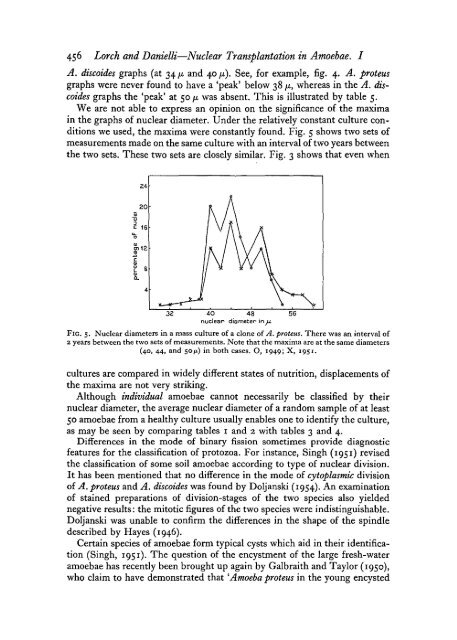Nuclear Transplantation in Amoebae. I. - Journal of Cell Science
Nuclear Transplantation in Amoebae. I. - Journal of Cell Science
Nuclear Transplantation in Amoebae. I. - Journal of Cell Science
Create successful ePaper yourself
Turn your PDF publications into a flip-book with our unique Google optimized e-Paper software.
45° Larch and Danielli—<strong>Nuclear</strong> <strong>Transplantation</strong> <strong>in</strong> <strong>Amoebae</strong>. I<br />
A. discoides graphs (at 34 //. and 40 JJL). See, for example, fig. 4. A. proteus<br />
graphs were never found to have a 'peak' below 38 fi, whereas <strong>in</strong> the A. discoides<br />
graphs the 'peak' at 50 /x was absent. This is illustrated by table 5.<br />
We are not able to express an op<strong>in</strong>ion on the significance <strong>of</strong> the maxima<br />
<strong>in</strong> the graphs <strong>of</strong> nuclear diameter. Under the relatively constant culture conditions<br />
we used, the maxima were constantly found. Fig. 5 shows two sets <strong>of</strong><br />
measurements made on the same culture with an <strong>in</strong>terval <strong>of</strong> two years between<br />
the two sets. These two sets are closely similar. Fig. 3 shows that even when<br />
FIG. 5. <strong>Nuclear</strong> diameters <strong>in</strong> a mass culture <strong>of</strong> a clone <strong>of</strong> A. proteus. There was an <strong>in</strong>terval <strong>of</strong><br />
2 years between the two sets <strong>of</strong> measurements. Note that the maxima are at the same diameters<br />
(40, 44, and 5Ofi) <strong>in</strong> both cases. O, 1949; X, 1951.<br />
cultures are compared <strong>in</strong> widely different states <strong>of</strong> nutrition, displacements <strong>of</strong><br />
the maxima are not very strik<strong>in</strong>g.<br />
Although <strong>in</strong>dividual amoebae cannot necessarily be classified by their<br />
nuclear diameter, the average nuclear diameter <strong>of</strong> a random sample <strong>of</strong> at least<br />
50 amoebae from a healthy culture usually enables one to identify the culture,<br />
as may be seen by compar<strong>in</strong>g tables 1 and 2 with tables 3 and 4.<br />
Differences <strong>in</strong> the mode <strong>of</strong> b<strong>in</strong>ary fission sometimes provide diagnostic<br />
features for the classification <strong>of</strong> protozoa. For <strong>in</strong>stance, S<strong>in</strong>gh (1951) revised<br />
the classification <strong>of</strong> some soil amoebae accord<strong>in</strong>g to type <strong>of</strong> nuclear division.<br />
It has been mentioned that no difference <strong>in</strong> the mode <strong>of</strong> cytoplasmic division<br />
<strong>of</strong> A. proteus and A. discoides was found by Doljanski (1954). An exam<strong>in</strong>ation<br />
<strong>of</strong> sta<strong>in</strong>ed preparations <strong>of</strong> division-stages <strong>of</strong> the two species also yielded<br />
negative results: the mitotic figures <strong>of</strong> the two species were <strong>in</strong>dist<strong>in</strong>guishable.<br />
Doljanski was unable to confirm the differences <strong>in</strong> the shape <strong>of</strong> the sp<strong>in</strong>dle<br />
described by Hayes (1946).<br />
Certa<strong>in</strong> species <strong>of</strong> amoebae form typical cysts which aid <strong>in</strong> their identification<br />
(S<strong>in</strong>gh, 1951). The question <strong>of</strong> the encystment <strong>of</strong> the large fresh-water<br />
amoebae has recently been brought up aga<strong>in</strong> by Galbraith and Taylor (1950),<br />
who claim to have demonstrated that 'Amoeba proteus <strong>in</strong> the young encysted
















